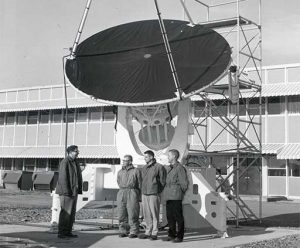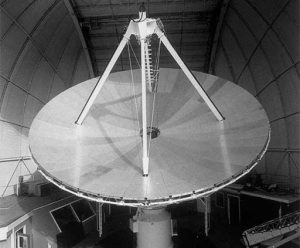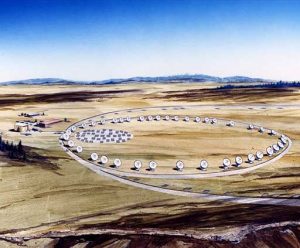In 1962, Dr Frank Drake in Green Bank became interested in experiments happening in telescope and receiver designs for detecting millimeter wavelengths, a shorter form of radio waves that is closer to infrared radiation. With them, he hoped to pursue observations of moons, comets, and the planets in our Solar System from the Observatory in Green Bank.
5-foot
Drake arranged for a 5-foot telescope to be erected on the old 12-foot’s small control building. Its pointing could be remotely controlled from this building or by closed-circuit television from the more climate-controlled Jansky Lab.
With the 5-foot telescope, Drake studied the Sun’s changing atmosphere, the temperatures on the Moon, and the clouds of Jupiter and Venus. He found puzzling temperatures on Venus that would later be explained as a runaway greenhouse effect, also intensity fluctuations of Jupiter that Drake proposed as evidence of Van Allen-type belts. Both of his theories would be proven correct. This little telescope also told astronomers that the dark maria on the Moon are colder than the highlands.
12-foot and 3-foot

The old 12-foot telescope, originally used a receiver-testing telescope for the Tatel Telescope, was repurposed as a millimeter-wave telescope. Millimeter waves are higher-frequency radio waves and require a near-mirrored dish surface to reflect the smaller waves accurately into receivers. The 12-foot’s surface was coated in gold to improve its smoothness. The dish was taken off of its control building and erected on a modified surplus radar mount behind the Janksy Lab. A 3-foot, gold-coated telescope was built to design and test new receivers for it.
Successful observations with these small millimeter-wave gathering telescopes convinced the National Science Foundation to budget construction of a 36-foot millimeter-wave telescope on the 6,000-foot high, dry site of Kitt Peak, Arizona. The dryness of Arizona’s skies is critical to millimeter-wave observations, because water vapor is a millimeter-wave static signal.
36-foot
The 36-foot telescope began observations in 1968, and was the telescope responsible for the methodical study of millimeter-wavelength molecular astronomy, also known as astrochemistry. During a period of explosive growth in this new area of astronomical research, dozens of molecules were first detected in space by the 36-foot, including carbon monoxide, silicon monoxide, and ethyl alcohol.
Molecules such as the ones found and observed by the 36-foot are most common in the densely packed regions of space near the center of our Galaxy and out in its spiral arms where clouds collapse into new stars. The 36-foot was helpful in tracing the shapes of the arms and thus the structure of our Galaxy.

In 1984, the telescope’s reflecting surface and surface support structure were replaced and the 36-foot was re-christened the 12-meter. Subsequently, the scientific program evolved from one dominated by astrochemistry to one that added a broader mix of observations. Using receivers that spanned from 68 GHz to 300 GHz, astronomers studied molecular clouds, Galactic star formation, aging stars, and external galaxies.
More than 150 international scientists made use of the 12-meter telescope every year. It offered them flexibility and the opportunity to respond quickly to new scientific developments. For decades, it was the only national scientific facility for millimeter wave astronomy.
In 2000, the NRAO ended its operations of the 12-meter, the Arizona Radio Observatory of the University of Arizona took ownership. They ran it until December 2012 when it was dismantled to make room for one of the 12-meter ALMA prototype antennas.
12-meter Telescope Stats
- Reflector: 12m diameter paraboloid enclosed within an Astrodome
- Elevation: 1914 meters (6280 feet)
- Pointing Accuracy: 5 arcseconds
- Receivers: From 68-180 GHz
25-meter and 65-meter Telescopes
In the 1970s, NRAO astronomers and telescope innovators Sebastian von Hoerner and John Findlay proposed designs for two large-scale millimeter-wave gathering telescopes. These projects did not get funding, but the ideas lingered and would later be used to design the 12-meter ALMA dishes and the 25-meter Cornell Caltech Atacama Telescope (CCAT).
Millimeter Array
Frank Drake had suggested in the early days of his millimeter-wave experiments that an array of such telescopes would be a critical investment for the research community. The successes with the 12-meter increased momentum for such a large-scale undertaking; however, our budget was being spent building the Very Large Array in New Mexico, which we completed in 1979.
In 1983, a committee chaired by Alan Barrett (other committee members were Charles J. Lada, Patrick Palmer, Lewis E. Snyder, and William J. Welch) suggested priorities for the future of millimeter and submillimeter astronomy at the request of the National Science Foundation. From this grew the specific ideas for such an array described in the Millimeter Array Design Concept.

In 1985 and again in 1989, Millimeter Array Science Workshops were held to discuss the scientific and array design goals for a millimeter array (MMA).
In September of 1990, Associated Universities, Incorporated, submitted our proposal for the MMA to the National Science Foundation (NSF). In May of 1991, the National Academy of Sciences Decade Review of Astronomy recommended the MMA as one of two major initiatives in ground-based astronomy for the decade of the 1990s. It was endorsed in October of 1991, and in September of 1992 we submitted the fleshed-out design plan.
On 18 November 1994, the National Science Board of the National Science Foundation approved our MMA plan. By Fall of 1997, Congress approved funding which commenced on June 1st, 1998.
During the 1990s, Japan and Europe were also considering millimeter arrays, and a joint partnership grew out of an international desire to build one enormous project that no single nation could afford. After a site selection of the Atacama Desert in northern Chile, the project then became known as the Atacama Large Millimeter/submillimeter Array (ALMA).
In the News
There were no posts found.





